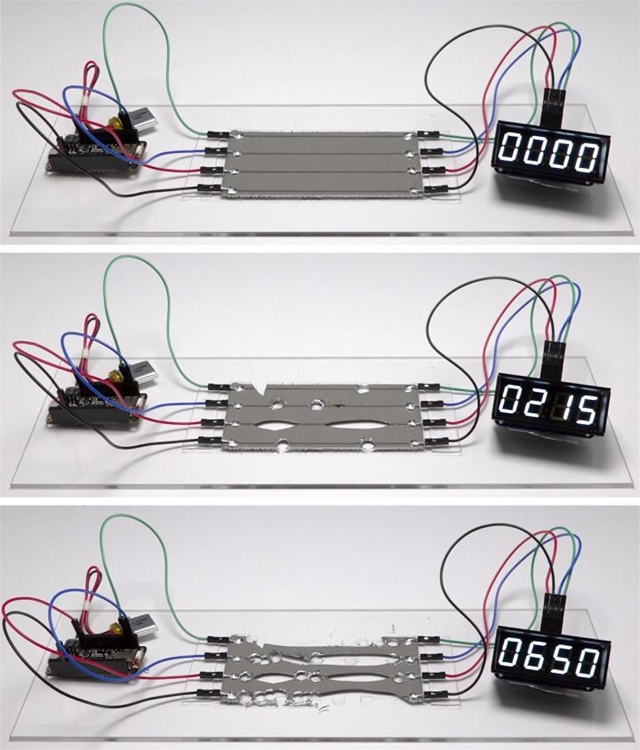
Tests of self-repairing circuits with a digital counter that keeps functioning, even when broken and material is removed. (courtesy, Nature Materials)
22 May 2018. Materials scientists and engineers developed the ability for electronic circuits in soft materials, like those found in wearable devices, to repair themselves if ruptured. A team from Carnegie Mellon University in Pittsburgh describes the technology in yesterday’s issue of the journal Nature Materials (paid subscription required).
Researchers led by mechanical engineering professor Carmel Majidi are seeking ways to make more robust electronic circuits in soft materials used in robotic devices that come in contact with humans, as well as wearable devices linked to mobile systems. Their goal, says Majidi in a university statement, is to have circuits in these materials restore their functions should they break. “Other research in soft electronics,” notes Majidi, “has resulted in materials that are elastic and deformable, but still vulnerable to mechanical damage that causes immediate electrical failure.”
Majidi’s Integrated Soft Materials Lab studies new types of electronics that simulate the mechanical properties of human tissue. The researchers work with highly elastic silicone polymers having tiny microscale channels embedded in the material. Those channels contain liquefied metal alloy, such as galium, that remains in liquid form, even as the surrounding flexible materials bends and stretches.
In the new study, the researchers tested the ability of the liquid metal to restore its connections if broken. The circuits in this case are made with liquid metal droplets, which if the circuits are ruptured, reconnect with other nearby droplets, enabling the electronic connections to be restored. The team says this rerouting process takes place spontaneously, without manual intervention or external heat sources.
Tests of the materials show restoration of these circuits, when the circuits are severed, punctured, and even if material is removed. The researchers also evaluated the circuits under more real-life conditions in working devices, such as a digital counter and a miniature quadruped robot. The results show the digital counter circuits repair themselves when broken and the robot continues to function, even after encountering significant damage (see image below).
“The unprecedented level of functionality of our self-healing material,” says Majidi, “can enable soft-matter electronics and machines to exhibit the extraordinary resilience of soft biological tissue and organisms.” In addition to wearable devices and soft robotics, the researchers envision self-repairing circuits being used by first-responder robots performing human rescues even if damaged, and with inflatable structures in remote locations, even under extreme environmental conditions, such as on the planet Mars.

Miniature quadruped robot keeps functioning, even after researchers physically break circuits (Carnegie Mellon University)
More from Science & Enterprise:
- Infographic – Graphene Investment in Decline
- Paper Art Form Boosts Bandage, Wearables Adhesion
- 3-D Printing Devised for Sensors in Soft Robotics
- Highly Stretchable Sensors Devised for Wearable Devices
- Lab Burns Graphene Circuits into Food, Fabrics
* * *

 RSS - Posts
RSS - Posts
[…] Self-Repair Developed for Soft Materials Circuits […]